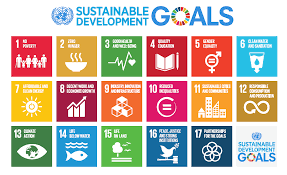Being that we are solidly in the 21st century, it shouldn’t be surprising that technology is involved in everything, including advancing global health. Because the Sustainable Development Goals of the U.N. are so bold, one of the best ways to get closer to meeting them faster is using innovative technology to our advantage. It is clear the technology can be used to improve health around the world as a tool to quicken the progress towards improving global health results, especially in low and middle income countries.
Photo obtained from: : https://www.un.org/sustainabledevelopment/blog/2015/09/why-should-you-care-about-the-sustainable-development-goals/
Digital health in particular is important to consider when discussing the relationship between technology and global health. Digital health includes many concepts, including mobile health, health information systems, telehealth, telemedicine, wearable devices, health information technology, and more. Digital health can be separated into 3 main areas (Sciences, Engineering, and Medicine, 2017):
- Using health information systems to catch, store, manage, or communicate information regarding patient health or health facility services.
- The delivery of important health information to healthcare professionals and health consumers using the internet and other forms of telecommunication.
- Using information and communication technology to better public health services (like through training and educating healthcare workers for example).
The World Health Organization has a Global Initiative on Health Technologies that they are hoping will make the benefits of health technologies available to populations in resource-limited settings, in an effort to control imperative health problems (Global initiative on health technologies, 2011). The Initiative has two objectives: the first is to encourage the international community to create a framework to develop National Health Technology Programmes that will affect the burden of disease and confirm the most effective use of resources (Global initiative on health technologies, 2011). The second is to challenge the scientific and business community to find and adapt “innovative” technologies that could have an impactful effect on public health (Global initiative on health technologies, 2011).

Glass globe and phonendoscope on the white surface. Photo obtained from https://www.medicalbag.com/home/medicine/strategies-and-considerations-for-improving-global-healthcare/
Excitingly, more breakthroughs could be on the way. In 2012, Lawrence Berkeley National Lab’s Institute for Globally Transformative Technologies began a study to find the “50 most important technology breakthroughs” needed for sustainable global development (Buluswar , 2014). This was began with the idea that knowing these technology breakthroughs will help those working in the field know what to put their collective efforts towards (Buluswar , 2014). Working with over 1000 experts, they analyzed where emerging technologies can make a huge difference in the areas of global health, agriculture and food security, human rights, education, access to water, the digital divide, access to electricity, gender equity, and fighting climate change (Buluswar , 2014). Big goals, right? One of the seven amazing and important breakthroughs identified is “a tool to diagnose several diseases” (Buluswar , 2014). Already a lot of advancements have been made on many diagnostic technologies (including nucleic acid tests and dipstick-type immunoassays), but it is imperative to use technology to integrate these different tests into one tool so that so that patients can get fast, accurate results on the first visit (Buluswar , 2014). Another related to technology is using solar-powered devices for child, primary, and maternal healthcare (Buluswar, 2014). As of 2014, building an averagely equipped clinic can cost over $100,000 (Buluswar , 2014). Additionally, devices needed to be successful are usually hard to install, complicated to use, and cost a lot to maintain (Buluswar , 2014). Using technology to develop a suite that has the main 10-15 devices and designed in a way to make easy installation and use a “clinic-in-a-box” (which costs less than $10,000) would not only improve health in rural areas but help save lives too (Buluswar , 2014). If you’re interested in learning more about the top medical technologies of the future, watch this video!
Unfortunately, the upward climbing of potential digital technology health solutions is usually slowed by many factors, including a limited amount of peer support and leadership management, a lack of coordinated funding working with government priorities, and a shortage of cheap and easily re-used adapted technologies ( like those made with open source software) (Sciences, Engineering, and Medicine, 2017). Experts believe that creating digital health-focused public-private partnerships based on government and community priorities can help to link stakeholders inside the digital health environment, can help encourage integration and coordination, increase the potential for impact, and involve the private and public sector stakeholders in fixing current challenges (Sciences, Engineering, and Medicine, 2017).
References
Buluswar, S. (2014, December 17). Seven breakthroughs that will transform global health. Retrieved November 16, 2020, from https://www.theguardian.com/global-development-professionals-network/2014/dec/17/seven-breakthroughs-transform-global-health-technology
How American Policy & Funding are Addressing Gender-Based Violence Globally. (2019, October 01). Retrieved November 12, 2020, from https://www.futureswithoutviolence.org/american-policy-funding-addressing-gender-based-violence-globally/
Sciences, Engineering, and Medicine, N. (2017, November 17). Introduction. Retrieved November 16, 2020, from https://www.ncbi.nlm.nih.gov/books/NBK538094/



Thank you for sharing the link for the video Top 10 Medical Technologies. He reordered it on January 2020, and he was right about Telehealth. It showed to be the future of clinical appointments, because as soon as the pandemic started a lot of health care was shifted through Telehealth.
Loved the idea of ‘clinic in a box’ and the cost comparison between an actual multifunctional clinic vs a digital clinic!